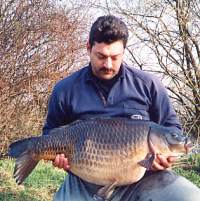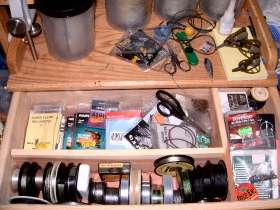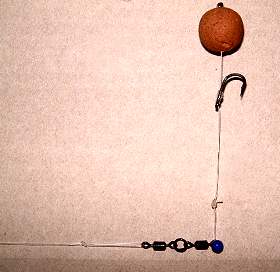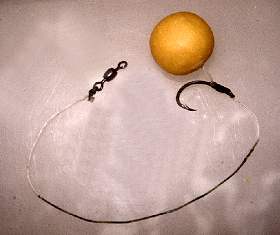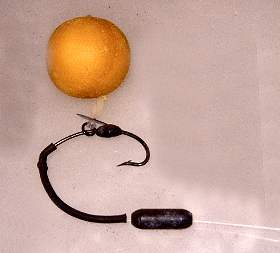|
|
| |
Rik started fishing at the age of four on his local tiny tidal river, catching eels and small wild trout on worm.
Not having had any angling family members, all his early fishing was solitary and this seems to have carried through to the present.
Like most anglers nowadays, he has a full time job and a family, so his fishing time is limited, although he does, he tells us, have a very understanding wife.He currently lives in the depths of Hampshire, and so is within easy reach of some excellent venues.
He has in the past, and still does, fish for most species, although his greatest love is for carp fishing, which is how the majority of his time is spent.
He now finds himself more thrilled with overcoming the intricacies and problems associated with catching carp, rather than the actual weight of the fish he catches and the so-called glory that goes with it.
The Hair Rig
This is the first in a series of short articles that will get backto the basics of carping and will, primarily, be focused towards thebeginners and occasional carpers. Hardened carpers, however, would beunwise to ignore these articles, as relearning the fundamentals canrefocus your attention and greatly increase your chances.
If anybody would like a certain area or topic covered then pleaseeither mail myself at carp.angler@talk21.comor the editor at graham@fishingmagic.com
This first article is going to cover the basic principles of thehair rig. There are references to baits being tied to the hook datingback to the 18th century, but we’re only interested in two men whobrought this rig into modern carp fishing, they are Lennie Middletonand Kevin Maddocks.
|
|
| |
They developed this rig to overcome the problems they had withwary, shy-biting carp at the time when fishing was either free-liningor with very light leads. This was because it was thought that anyresistance would be felt by the carp and they would drop thebait.
By now, most carpers were using a special boiled paste of somedescription and the school of thought was to bury the hook inside thebait so the fish couldn’t see or feel it. This presented the problemof not being able to strike through the bait when you got a bite.
People then started side-hooking baits so that the hookpointwasn’t masked.
But the problem of the bait not acting naturally remained becauseit was still attached to rather thick, stiff and heavy mono.
During some tank tests these two chaps noticed the carp sucking atbaits from a distance and then chewing the bait up in their throatteeth. They hypothesised that if a carp could be fooled into taking abait into its throat teeth, then they wanted the hook following it sothat a hookhold could be found in the mouth area.
To make the bait act as naturally as possible they decided thatthe link attaching the bait to the hook should be as fine as theycould find.
|
|
| |
The original experiments used a hair from the head of Kevin’swife, and thus the rig’s name was born. This proved to be too fragileand they settled for 1lb mono and tied the baits to the bend of thehook.
The length of the hair was set to about 3 inches, as this was thedistance between the throat teeth and the lips on an average carp.They had a few problems with carp being hooked outside the mouth, solater this was shortened to about 2 inches.
Their initial trials with the rig produced amazing amounts ofactivity from the carp.
Before the hair most bites from carp were tiny twitches and pullsthat needed striking with lightning reflexes. When using hair-riggedbaits they found that the carp were taking the bait so confidentlythat they were getting searing runs which they were strikinginstantly, but the carp hadn’t had time to shift the bait and hookinto its mouth.
In an attempt to resolve the issue of premature striking Kevinactually removed the handles from his reels so that when he got a runhe had to replace the handles before he could strike. This enforced along enough delay to allow the carp to get the hook into its mouth.That solved the problem and the carp were then hookedsuccessfully.
|
|
| |
Lennie’s catches were never really published, but Kevin went on torecord some amazing catches of carp, and became the first man tocatch twenty 20lb carp in a season plus numerous lumps from some verydifficult venues.
With so much success coming their way, all eyes were on them andeventually the secret of “The Hair” was out.
The rest, as they say, is history.
An understanding of the mechanics of the basic rig, why it worksand what won’t work, will allow you to either use the available rigswith confidence in the correct situation or to experiment with yourown choices.
Important questions to ask yourself are:
- Is it tangle proof?
- Does it present the bait how you want it to?
- Does it put the hook where you want it?
- Is the hook-to-bait separation what you expect?
- When the bait is either picked up or sucked in, will the rig work as you expect it to?
|
|
| |
After tying, trying and experimenting with every possiblepermutation of rig design I will offer this very important piece ofadvice……..keep it simple.
My rigs start from a lightweight size 10 hook with a longish hairand 24 inches of 8lb braid, to a 2 inch, 30lb Amnesia link with asize 4 hook and a hair for fishing with two 24mm pop-ups. I also useeverything in between.
I cannot tell you what rig to use, but my rig choice will dependon the bait I am using, the type of loose feed, the bottom in thefeeding area, the distance I am fishing and the size of fishexpected.
Experiment with your rig choice, but also understand why a certainrig works in a given situation.
In Part 2 of this article I will detail a few rigs and thereasoning behind their use.
Until then…










